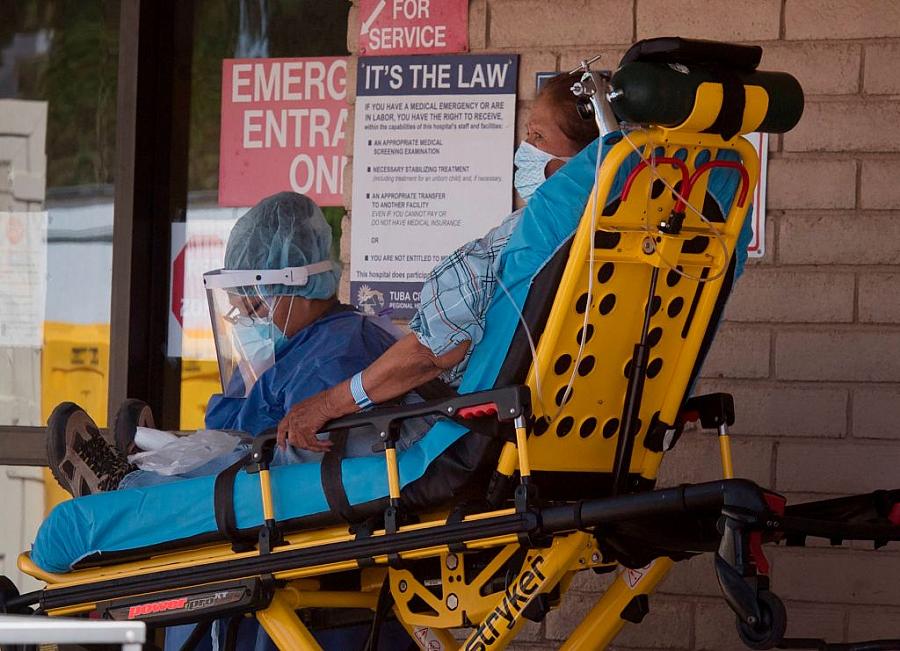Timely insights for reporting on Native American health during COVID-19

A patient is taken from an ambulance to the emergency room of a hospital in the Navajo Nation town of Tuba City in late May.
(Photo by Mark Ralston/AFP via Getty Images)
With the most COVID-19 cases per capita in the United States and just 25 ICU beds, it’s been a trying time in the southern region of the Navajo Nation, said Dr. Michelle Tom, a family medicine physician with the Winslow Indian Health Care Center in Arizona.
The ICU bed shortage has forced providers to send some critically ill patients to other facilities statewide, often via helicopter, a stressful transport that can increase their risk of death.
“You would not want to be in a situation like this when you’re in acute respiratory distress and really striving to breathe,” she told reporters virtually attending this week’s 2020 National Fellowship.
Tom joined Dr. Mary Owen, the director of the Center of American Indian and Minority Health, and Joaqlin Estus, a reporter with Indian Country Today, to discuss the health care history of Native Americans, health disparities exposed by the pandemic, and how journalists can cover these topics without relying on damaging stereotypes and clichés.
COVID-19 in the Navajo Nation
Tom described the challenges involved in transferring patients when ICU beds are filled, a process that can delay care and harm a patient’s health.
She will sometimes wait hours to talk to an accepting provider in places such as Phoenix. Once the transfer is arranged, the helicopter will ideally come within 15 minutes, but she’s had to wait hours. Even after the lengthy travel process, more time is needed at the transfer facility for fresh labs and imaging since the patient’s health may have deteriorated in transit.
The hardest part, though, is transferring patients who only speak Navajo, something she experiences with “a lot” of her patients, she said.
“Once they leave, they feel like they’re living in a foreign country,” she said. “We all know about medical errors in translation.”
Native Americans’ history with tuberculosis has made social distancing and mask wearing familiar practices. A key challenge, though, comes from urbanized youth who can be asymptomatic carriers, she said.
It’s hard to contact trace these asymptomatic carriers as they come and go in multigenerational homes. Plus, there are communication challenges in rural areas without phone service.
Exposing systemwide problems
The pandemic has exposed broader challenges with the Native American health care system, said Owen, who teaches at the University of Minnesota Medical School.
“COVID has exposed the result of decades of underfunding and inaction,” she said.
The United States has a “trust responsibility” to provide Native Americans health care, something she emphasized is not “free” for tribe members.
“We gave up plenty of land and rights and we went through genocide and much more to get this health care responsibility,” she said.
Despite that obligation, the government has failed to fully fund Native American’s health needs, she said. Some of the disparities relating to COVID-19 are a direct result of underfunding, she said, pointing to aging medical facilities and high provider vacancy rates.
Avoid clichés and stereotypes
When covering these topics, it’s important for reporters to avoid clichés and stereotypes, said reporter Estus, who has extensively covered Alaskan natives for Indian Country Today and other outlets.
One study from the Native American Journalists Association (NAJA) looked at hundreds of articles from various outlets. While some articles were fair and offered in-depth coverage of contemporary life, many also relied on clichés and stereotypes. These included references to mascots, casinos and life “on the res,” she said.
More than half of the articles contained terms that demonstrated a limited knowledge of Indigenous peoples, such as “poverty,” “reservation,” “drugs,” “addiction,” “alcohol” and “drums.” Using too many of these ideas in an article may represent cliched storytelling, or a lack of experience reporting in Indian Country, according to the association. Reporters at risk of using too many of these stereotypes might consider consulting NAJA for advice.
Estus also stressed how offensive the “R-word” is to Native Americans, yet it’s still used in headlines for articles that describe the Washington NFL team.
With too many articles relying on official interviews only, Estus suggested that journalists get to know sources in their native communities before there is a news story. Since connecting with someone at the Indian Health Services can be tough, try reaching out to tribal organizations directly, she said.
Optimism ahead
Owen noted that the CDC has begun publishing more data by race and ethnicity, one of many changes she’s noticed in the wake of the Black Lives Matter protests.
Her own experience also reflects changing attitudes, she said as she’s been asked to teach about structural determinants of health and the impact on underserved communities. It’s too soon to tell if these shifts will have a lasting impact, but it could translate into more informed providers, she said.
Tom said she’s also sees signs of hope in the “unprecedented” number of Native topics appearing in U.S. media, as the national conversation expands to include more voices from marginalized groups.
“It’s great to have this feeling,” Tom said. “It’s way overdue.”

